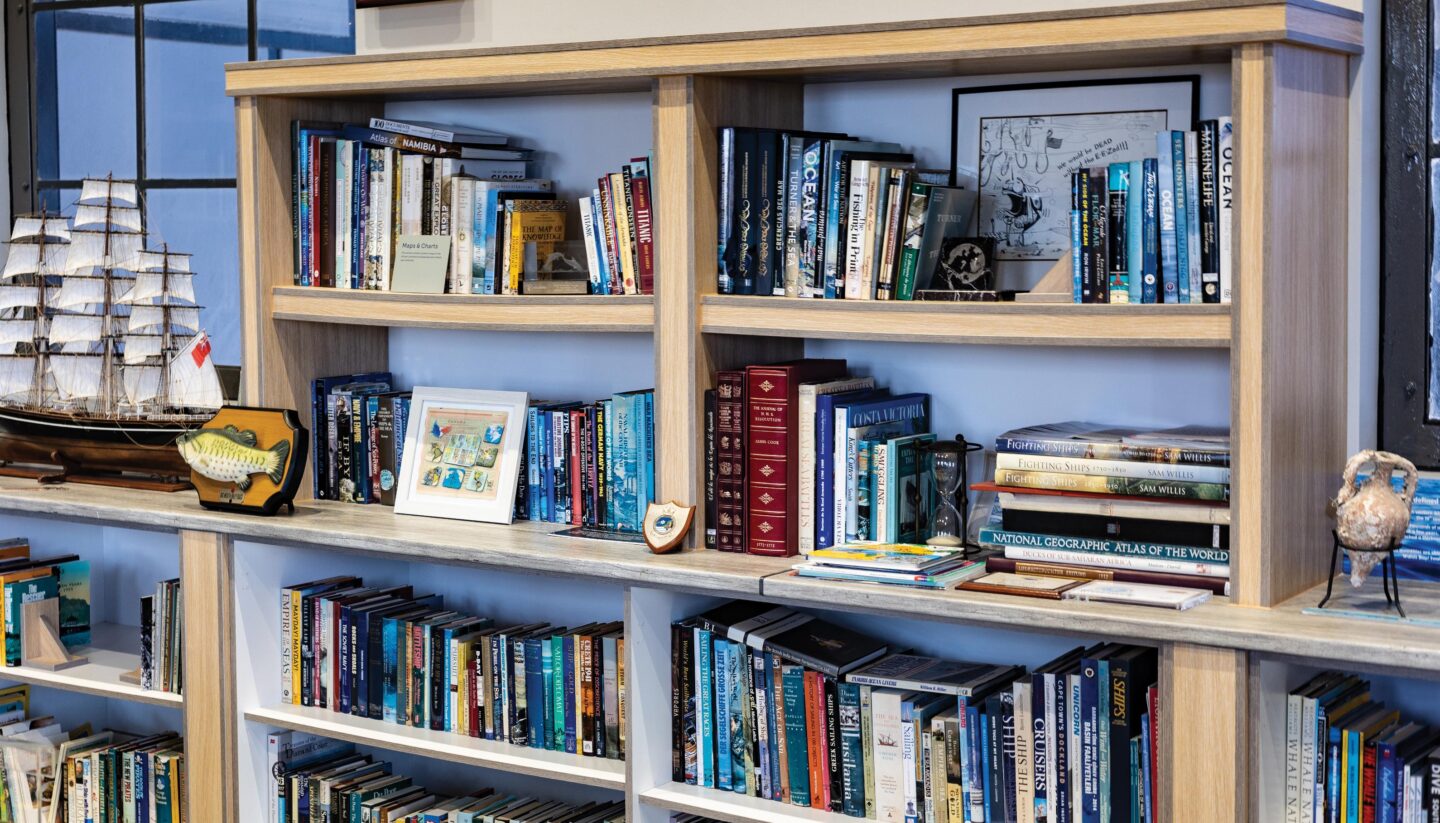

Oceans of insight
Discovering Namibia’s first Maritime Museum in Lüderitz
Anchors, propellers, masts, winches and an artistic sundial are arranged to create an outdoor walkway that marks the beginning of your journey through time and all things maritime. As we step into the newly opened Maritime Museum in Lüderitz, we are about to explore a rich and fascinating past. This world-class tourist attraction celebrates the town’s seafaring heritage and its deep connection to the ocean. Having visited maritime museums around the globe, I can confidently say that this one is as captivating as its international counterparts. Housed within the restored historic Lüderitz Old Power Station on Dias Street, the museum spans five floors, taking visitors back in time while also highlighting contemporary interactions with the ocean.
Text Kirsty Watermeyer | Photographs Kirsty Watermeyer
From the Summer 2024/25 issue
Visitors can explore artefacts from shipwrecks, navigation tools and equipment used by local fishermen, all of which provide a tangible connection to Lüderitz’s seafaring past. Detailed displays narrate the stories of early explorers and traders, bringing their adventures to life.
I was fortunate to have a sneak peek inside Namibia’s first maritime museum before it opened to the public, guided through the building by museum curator and historian Eino Ngesheya, who is a true custodian of maritime knowledge. I found myself captivated, hanging on Ngesheya’s every word. Every corner of this five-storey building has been expertly curated, offering opportunities for learning and discovery at every turn.
One of the standout features of the museum is its impressive collection of ship models. “We have the largest collection in Southern Africa, with about 220 models from various time periods,” Ngesheya shares with pride. Each model is a work of art, showcasing the evolution of maritime technology and its significance in shaping historical development.
As visitors explore the exhibits, they are encouraged to reflect on the historical importance of watercraft. Ngesheya emphasises that watercraft is the earliest form of transportation and adds, “Initially, propulsion was achieved through manpower and animals, but this changed with the discovery of wind power.” The collection is extensive, and each model ship tells a story, such as the Roman ceremonial vessel which symbolises ancient connections across the seas. “This model represents a Roman ceremonial vessel used by Julius Caesar,” says Ngesheya when asked about it.
But the museum is not just an incredible collection of model ships; there is also an impressive collection of commemorative coins. “These coins honour our rich maritime heritage and remind us of the people and events that shaped our relationship with the sea,” says Ngesheya. In addition, there are drawers and shelves filled with marine artefacts, seashells and historical documents from various parts of the world. Ngesheya quips, “If it’s not related to the sea, it doesn’t belong here!”

“Interactive exhibits educate visitors about the diverse marine ecosystems off the Namibian coast, highlighting the importance of sustainable fishing practices and the conservation of marine resources.”
Another notable highlight in the collection of historical artefacts is the Library of Maritime Literature. This temperature- controlled library houses a variety of publications, including first editions, historical marvels, maps and more. With each exhibit, the museum not only educates visitors but also inspires a deeper appreciation for the ocean and its vital role in Namibia’s history and culture.
Highly interactive and immersive, a fully restored research vessel – once used by the Ministry of Fisheries and Marine Resources – invites visitors to explore a fully operational ship while enjoying a bite to eat on board.
Another fascinating aspect of your visit is the journey through time, from past to present. You can explore giant seashells and shark skeletons, learn about the safety standards established after the sinking of the Titanic, and examine the equipment used by speed surfers during the annual Lüderitz Speed Challenge.
The museum places a strong emphasis on the environmental aspects of maritime life. Interactive exhibits educate visitors about the diverse marine ecosystems off the Namibian coast, highlighting the importance of sustainable fishing practices and the conservation of marine resources. This dual focus on history and ecology reflects a commitment to fostering a deeper understanding of the relationship between the community and the ocean, ensuring that visitors leave with not just knowledge but a sense of responsibility towards marine conservation.
As Ngesheya explains, “We strive to create an engaging experience for our visitors. Whether it’s through soft cubes for children to sit on or interactive elements, we want everyone to feel connected to our maritime history.” This commitment to inclusivity ensures that all guests leave with a deeper understanding and appreciation of the region’s nautical past.
At the top of the building, a realistic captain’s seat from a ship allows visitors to envision themselves as a seafarer of the past. Surrounded by authentic equipment and tools reminiscent of those used on vessels of bygone eras, a visit to the museum is an immersive experience that will transport you back in time.
The Namibia Maritime Museum is an initiative of the Lüderitz Waterfront Development Company and spearheaded by its board chairman, Angel Tordesillas. At the official opening of the Maritime Museum, Namibian President Nangolo Mbumba said, “Our coast, stretching 1,572 kilometres along the Atlantic Ocean, has been central to trade, exploration and cultural exchange for centuries. This museum stands as a resource for discovering our rich maritime history and understanding the ocean’s economic significance.”
The museum also plays a vital role in the local community by hosting temporary exhibitions and educational programmes. These initiatives encourage engagement with local schools and residents, fostering a love for maritime knowledge and appreciation among visitors and the community alike. Special events, such as lectures and workshops, are organised to promote Namibia’s maritime heritage and environmental awareness.
The Lüderitz Maritime Museum is more than just a collection of artefacts; it is a vibrant celebration of the sea and its integral role in shaping the identity of Lüderitz. It stands as a remarkable tribute to the community’s nautical heritage and its significance as a key port in Namibia, all set against the stunning backdrop of the Atlantic Ocean.
For those exploring Lüderitz, the Maritime Museum offers a captivating journey through time, blending stories of adventure, survival and the pressing issues of modern marine conservation. It stands as a testament to the town’s enduring connection to the sea, inviting visitors to appreciate not only the beauty of the ocean but also its profound impact on the lives of those who call this coastal region home. TN
More to explore

Discover Airlines launches a new direct flight between Windhoek and Munich






